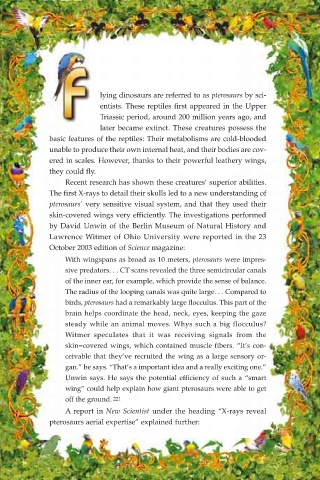Page 249 - The Origin of Birds and Flight
P. 249
lying dinosaurs are referred to as pterosaurs by sci-
entists. These reptiles first appeared in the Upper
Triassic period, around 200 million years ago, and
later became extinct. These creatures possess the
basic features of the reptiles: Their metabolisms are cold-blooded
unable to produce their own internal heat, and their bodies are cov-
ered in scales. However, thanks to their powerful leathery wings,
they could fly.
Recent research has shown these creatures’ superior abilities.
The first X-rays to detail their skulls led to a new understanding of
pterosaurs’ very sensitive visual system, and that they used their
skin-covered wings very efficiently. The investigations performed
by David Unwin of the Berlin Museum of Natural History and
Lawrence Witmer of Ohio University were reported in the 23
October 2003 edition of Science magazine:
With wingspans as broad as 10 meters, pterosaurs were impres-
sive predators. . . CT scans revealed the three semicircular canals
of the inner ear, for example, which provide the sense of balance.
The radius of the looping canals was quite large. . . Compared to
birds, pterosaurs had a remarkably large flocculus. This part of the
brain helps coordinate the head, neck, eyes, keeping the gaze
steady while an animal moves. Whys such a big flocculus?
Witmer speculates that it was receiving signals from the
skin=covered wings, which contained muscle fibers. “It’s con-
ceivable that they’ve recruited the wing as a large sensory or-
gan.” he says. “That’s a important idea and a really exciting one.”
Unwin says. He says the potential efficiency of such a “smart
wing” could help explain how giant pterosaurs were able to get
off the ground. 221
A report in New Scientist under the heading “X-rays reveal
pterosaurs aerial expertise” explained further:

